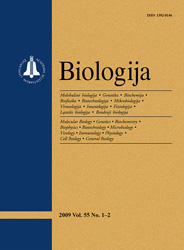Biologija / Biology
 ISSN 1392-0146 ISSN 2029-0578 (online) |
2005 m. Nr. 4 Main additive effect and multiplicative interaction
analysis of white clover genetic resources
Dry matter content in overground biomass in six varieties and four breeding populations of white clover (Trifolium repens L.) were studied at the Lithuanian Institute of Agriculture (Dotnuva) during the period 2001–2003. In this study, the AMMI model was used with the objective of assessing dry matter content in the overground biomass of white clover genotypes, selecting stable genotypes and investigating genotype by environments (G x E) effects. The effects of environments, genotypes and G x E interaction were highly significant (P < 0.01). The first two bilinear AMMI model terms accounted for 88%. The biplot showed three groups of genotypes: Nos. 1123 and 1124 unstable but high-yielding; varieties ‘Suduviai’, ‘Bitunai’, ‘Atoliai’ and No. 1421 stable but low or medium yielding; variety ‘Nemuniai’, ‘Rivendel’ and No. 1435 unstable, low or medium yielding. To breed a new ecologically stable variety of hite clover we intend to use the variety ‘Nemuniai’ and No. 1124 as initial material for hybridization. They have a high level of dry matter productivity but differ by GE response.
Keywords: white clover, AMMI model, biplot, yield stability |
Issues:
2011 - Vol.57 No. 1, No. 2, No. 3 2010 - Vol.56 No. 1-4 2009 - Vol.55 No. 1-2, No. 3-4 2008 - Vol.54 No. 1, No. 2, No. 3, No. 4 2007 - Vol.53 No. 1, No. 2, No. 3, No. 4 2006 No. 1, No. 2, No. 3, No. 4 2005 No. 1, No. 2, No. 3, No. 4 2004 No. 1, No. 2, No. 3, No. 4 2003 No. 1, No. 2, No. 3, No. 4 2002 No. 1, No. 2, No. 3, No. 4 2001 No. 1, No. 2, No. 3, No. 4 |